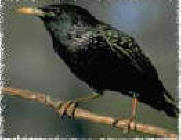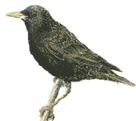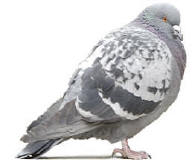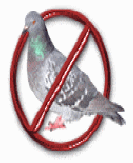|
The starling is a dark chunky, muscular bird. It is distinguished from other
blackbirds by its short tail and its longer, slender bill. Starling plumage
varies depending on the season. In winter, the bird displays a highly
speckled iridescent coat and a dark bill. In summer, the birdís coat dulls
and has far fewer speckles
Height/Weight
7.5"-8.5"
2-3oz
Life span
5-7 yrs. wild
13 yrs captivity
Flight speed
18-40 mph
Range
across country
rural to urban
Food
insects, wild fruit,
seeds & grain
Habitat
trees & building
structures, cactus

|
|
|
Pigeon
Sparrow Swallow
Starling
Woodpecker Crow
Grackles
Starling
Biology and Control Information
 Like the
house sparrow, the starling
(Sturnus Vulgaris) was introduced from Europe in the 19th century.
Starlings
did not spread as fast and only reached the western coast within the last few
decades. Starlings are well adapted to urban life which offer it an abundance of
food and nesting sites. It is a muscular bird about eight inches long with long
wings and a short squared
tail. Starlings are very aggressive and will drive native birds out of their
territory, much to the dismay of local bird watchers. Starlings are well noted
for their flocking habits. They often gather in the tens of thousands, creating
a nuisance when roosting in populated areas. Like the
house sparrow, the starling
(Sturnus Vulgaris) was introduced from Europe in the 19th century.
Starlings
did not spread as fast and only reached the western coast within the last few
decades. Starlings are well adapted to urban life which offer it an abundance of
food and nesting sites. It is a muscular bird about eight inches long with long
wings and a short squared
tail. Starlings are very aggressive and will drive native birds out of their
territory, much to the dismay of local bird watchers. Starlings are well noted
for their flocking habits. They often gather in the tens of thousands, creating
a nuisance when roosting in populated areas.
European Starlings weigh approximately 3.2 ounces; an average
starling is about the size of a robin. The adult starling has dark feathers
with speckles. Starling bills (both male and female) are yellow during
reproductive season (January to June), the rest of the year starling bills
are dark. Juvenile starlings have pale brown to gray bills. "Starlings are
chunky and hump-backed in appearance, with a shape similar to that of a
meadowlark. The tail is short, and the wings have a triangular shape when
outstretched in flight." Starling flight paths tend to be direct and swift.
Habitat:
Starlings can be found in various types of habitats "including cities,
towns, farms, ranches, open woodlands, fields, and lawns. Perfect nesting
habitats would include areas with trees or other structures that have
openings that are "suitable for nesting and short grass areas or grazed
pastures for foraging. During the winter, starlings live in areas where
nesting, roosting, and foraging for food and water is possible.
General Biology:
"European starlings were brought into the
United States from Europe. The were released in New York City in 1890 and
1891 by an individual who wanted to introduce to the United States all of
the birds mentioned in Shakespeare's works. Since that time, they have
increased in numbers and spread across the country. The starling population
is estimated at 140 million.
Starlings will nest in any cavity of a
structure, trees, birdhouses, or cliff faces. The female lays about 4 to 7
eggs which hatch 11 to 13 days after incubation. Young starlings will leave
the nest at about 21 days old. "Both parents help build the nest, incubate
the eggs, and feed the young." Starlings are not necessarily migratory, but
some will migrate up to several hundred miles, while others will remain in
the same general area. "Hatching-year starlings are more likely to migrate
than adults, and they tend to migrate farther." With the exception of
breeding season, starlings generally feed and roost together in flocks.
Research has shown that starlings can and will feed miles away from their
nests.
Starling and blackbird flocks often roost
together in urban landscape trees or in small dense woodlots or overcrowded
tree groves. These birds will choose trees that have plenty of perches so
that the whole flock can roost together. During the winter seasons,
starlings will move into dense vegetation or structures such as barns, urban
structures, and homes. Starlings always look for protection from the
climate.
Damage:
Starlings are considered pests due to all the problems they cause,
especially around livestock facilities and near urban roosts. Starlings are
responsible for "transferring disease from one livestock facility to
another. Tests have shown that the transmissible gastroenteritis virus (TGE)
can pass through the digestive tract of a starling and be infectious in the
starling feces. TGE can be transmitted on boots, vehicles, stray animals, or
already infected livestock.
Starlings cause other types of damage such as
consuming cultivated fruits and seeds from a recently planted field. "Large
roosts that occur in buildings, industrial structures, or, along with blackbird
species in trees near homes are a problem in both rural and urban sites because
of health concerns, filth, noise, and odor.
In addition, slippery accumulations of
droppings pose safety hazards at industrial structures, and the acidity of
droppings is corrosive."
Starlings that roost near airports create a
safety problem, with the possibility of the bird getting sucked into the
aircraft engines. One of the more serious health concerns that starlings have is
the "fungal respiratory disease histoplasmosis.
The fungus Histoplasmosis capsulatum can grow
in soils under bird roosts, and spores become airborne in dry weather,
especially when the site is disturbed. Histoplasmosis, in its most extreme state
can cause blindness and/or death. Another problem starlings have created is that
they are in competition with "native cavity-nesting birds such as bluebirds,
flickers, woodpeckers, purple martins.
Control
Starlings roosting habits can be modified permanently by
products using 1-1/8" mesh StealthNet and/or electrical systems like Bird-Shock and Hazing. For large flocks or agricultural applications, sometimes these birds
can be moved with a well-timed, organized scare campaign using strategically
placed sophisticated audio systems like the Bird
Wailer, Squawker, or the Bird-Guard units depending on the size of
the area. These products combine natural and electronic sounds like species
specific distress calls, predator hunting/attack sequences and canon or
shotgun sounds. Other noisemakers such as Zon Guns
and Bird Bombs & Screamers often have
success in relocating these bird when combined with lights and visual
frightening devices that flash such as Flash Tape, Scare Eye Balloons or Octopus. A new technique that has found
some success for moving populations from trees is to use a thermal fogger
hazer in the problem areas with ReJeX-iT, Force Fog.
Legal Status:
European Starlings are not protected by
federal law and in most cases state law does not offer them protection. Local Fish and Wildlife should be consulted before
any methods of treatment are applied.
not offer them protection. Local Fish and Wildlife should be consulted before
any methods of treatment are applied.
Acknowledgement:
Courtesy of The Wildlife Damage Handbook
|
|
|





